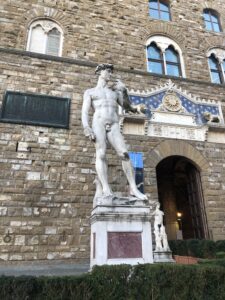 During the Renaissance, religion and politics were greatly intertwined. The popes held great power, therefore influential families tried to elect a pope that would bring them higher up the social ladder. The Medici family is a prime example of this quest for power. Originally bankers, they strategically married and made strong business connection. As a result, they quickly became one of the wealthiest and well known family in Florence. The Medici, along being involved with the politics of the time, were also large patrons of the Arts. They would house a variety of artists, including great artists such as Donatello and Michelangelo. As the Medici gained power, they had a stronger influence on Florence. The city’s values then reflected the values of the Medici.
During the Renaissance, religion and politics were greatly intertwined. The popes held great power, therefore influential families tried to elect a pope that would bring them higher up the social ladder. The Medici family is a prime example of this quest for power. Originally bankers, they strategically married and made strong business connection. As a result, they quickly became one of the wealthiest and well known family in Florence. The Medici, along being involved with the politics of the time, were also large patrons of the Arts. They would house a variety of artists, including great artists such as Donatello and Michelangelo. As the Medici gained power, they had a stronger influence on Florence. The city’s values then reflected the values of the Medici.
 When looking at the religious center of the city, the duomo, it demonstrates the competitive nature of both Florence and the Medici. Florence wanted to build the largest and most beautiful cathedral, as this would would be the image of the city presented to outsiders. It was not only a way to show religious piety, but also political dominance. The facade is awe-inspiring with its colorful and patterned marble. The exterior was made to be impressive, and as mentioned above, it served both a religious and political purpose. The grandeur of the building was to indicate the power of the divine. Though the Medici, who supported the erection of the Duomo, also used it to further establish their presence in the city and to win the favor of the people of Florence.
When looking at the religious center of the city, the duomo, it demonstrates the competitive nature of both Florence and the Medici. Florence wanted to build the largest and most beautiful cathedral, as this would would be the image of the city presented to outsiders. It was not only a way to show religious piety, but also political dominance. The facade is awe-inspiring with its colorful and patterned marble. The exterior was made to be impressive, and as mentioned above, it served both a religious and political purpose. The grandeur of the building was to indicate the power of the divine. Though the Medici, who supported the erection of the Duomo, also used it to further establish their presence in the city and to win the favor of the people of Florence.
 The Palazzo Vecchio, the political center, is a stark contrast from the Duomo. As opposed to decoration and beauty, the Palazzo Vecchio favors durability and practicality. Instead of marble they used thick bricks, and had multiple levels of defense, such as shooting arrows from the upper levels. However, the Palazzo Vecchio did not shun all beauty.The statue of David by Michelangelo was placed in front of the Palazzo Vecchio, as opposed to its intended placement on top of the
The Palazzo Vecchio, the political center, is a stark contrast from the Duomo. As opposed to decoration and beauty, the Palazzo Vecchio favors durability and practicality. Instead of marble they used thick bricks, and had multiple levels of defense, such as shooting arrows from the upper levels. However, the Palazzo Vecchio did not shun all beauty.The statue of David by Michelangelo was placed in front of the Palazzo Vecchio, as opposed to its intended placement on top of the
Duomo, as it was considered so beautiful that the people should be able to admire it closely. Though the David is not without political significance. David was the patron saint of Florence and a symbol of Florence’s power. This further demonstrates the connection of politics and religion, as it was not uncommon to use religious iconography in the political sphere.
Another important factor of the power structure of Florence were the guilds. The guilds restructured the economy, and organized workers. The guilds would also pay taxes, giving the city more funding. More importantly, however, was that the guilds were sources of power and wealth. One of the wealthiest guilds was the wool guild, which the Medici were prior to becoming bankers.
The guilds were not only places of trade and production, but also a way to make political alliances and deals all in an effort to rise the social ladder.
-Jana Blomberg, Ellie Johnson, and Sonja Quimby
Leave a Reply
You must be logged in to post a comment.